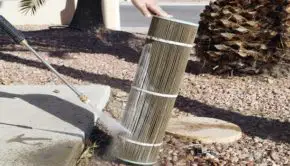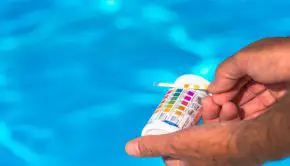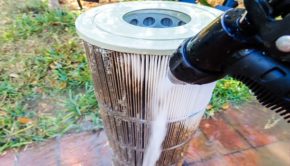10 Pool Maintenance Tips You Never Knew
DISCLOSURE: As an Amazon Associate, I earn from qualifying purchases.
Before you own a pool, the idea of owning one in your backyard is more like a vacation dream than the reality of actually owning one.
In truth, it takes work – regular, disciplined work – to keep your investment protected, your pool looking good and your family safe.
Without a solid pool maintenance routine, your swimming pool can quickly suffer from broken filters, an overworked pool pump, green water and algae build up – just to mention a few.
Besides, no one wants to get into a swimming pool that has seen its better days. So why did you spend all that money?
Here are 10 pool care tips you should consider implementing this year, if you aren’t already.
I guarantee you that some of these you’ve never heard of, like using old tennis balls to remove oils from the top of your water.
1. Skim Your Surface & Scrub Your Walls – Regularly
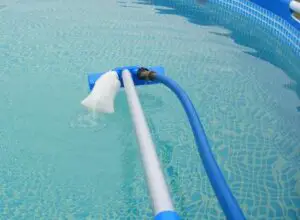
Skimming debris and leaves from the water’s surface is a no-brainer, but it bears repeating. If you live near or under trees, over-filled skimmer pots can quickly overwhelm your pool’s pump. And replacing a pool pump is not cheap.
Ideally, skimming should be done daily. If you don’t have trees nearby, then weekly might suffice.
You also have to scrub the sides of the pool to avoid algae build-up. That doesn’t have to be carried out frequently. By scrubbing once every seven days, you’ll get rid of algae build up. If you cannot or don’t want to do the work yourself, then consider buying a robot vacuum cleaner that can scrub the vertical surfaces of your pool.
If stubborn stains don’t go away with elbow grease, you might want to try using an old sock. Put some chlorine in it and allow it to sit for some hours before scrubbing again. The algae will be eaten away at by the chlorine – and you now have an excellent use for all those old socks.
2. Treat the Filter Like Your Pool’s Kidney
As your kidneys work to eliminate impurities from the body, your pool filter is responsible for removing contaminants from your pool water such as dirt, leaves and tiny particles.
The majority of the time, your pool pump filters should be cleaned by turning the filter off, eliminating the filter cap placed on the pool floor, pulling out the filter bin, and eliminating any trash before replacing everything. It’s ideal for washing out your filter basket at least once in ten days.
Once a month you also need to wash the pipes that the filter systems use, which you can accomplish through backwashing. To do this, just set your filter to “backwash,” blow out the leaf basket and wash it. After that, turn on your pump and let it run till the waste pipe starts throwing clean water.
A note re. turning off and on the filter: doing this too frequently can disturb the mechanisms of the filter.
Set the timer of the filter and let it operate for at least six hours every day.
3. Pools Need Consistent Chemical Levels

Chemical levels are among the most significant aspects of pool maintenance. Inappropriately balanced water may irritate eyes and skin, and appears murky and make your pool a breeding place for germs.
You need to test your pool water weekly. As per the Center for Disease Control (CDC), six chemical amounts need to be considered:
- Cyanuric Acid – Determines the required free chlorine level and protects it from the UV rays of the sun. Perfect reading for pools is 30-50.
- Free Chlorine- A sanitizer used to keep the pool water safe and germ-free.
- Acidity/Alkalinity — Also called the PH level, acidity has to be maintained between 7.5 and 7.8 to avoid irritation and protect the pool stuff from decaying.
- Total Alkalinity – Helps maintain the PH in equilibrium. The level must be in the range of 60-120.
- Calcium Hardness — Proper levels help prevent dirt damage. Consider 220-350, but lower for pools with vinyl siding.
Testing water & adjusting your chemicals balance is easy to do and only takes a few minutes from your week:
- Buy a proper testing kit from a nearby pool store or order it online.
- Fill it with water from your pool as a sample.
- Put the solution provided and shut the vials.
- After a few moments, your sample water will change color, and a comparison of the sample water into the colors displayed on the testing kit should enable you to ascertain the present chemical levels.
- You then need to adjust the levels as required to achieve an ideal balance.
When pool chemicals are correctly balanced, the water should be crystal clear, not have an odor, and should leave a no residue on your skin.
4. Chemicals Too Expensive? Give Baking Soda a Try
Pool chemicals can be expensive, so why not get help from the supermarket?
Most pool shops advise using sodium bicarbonate to control the alkalinity of a pool without reducing the PH levels. But they often try to sell you overpriced solutions to get the work done.
As it happens, regular baking soda has the exact same sodium bicarbonate for a fraction of the price.“Sodium bicarbonate” is present in all baking soda boxes even have labeled in their ingredients list. Have a look.
If you are concerned that baking soda will mean doing lots of complex mathematical conversions, do not think much. Baking soda contains the same amount of sodium bicarbonate as pool-branded solutions, so the quantity you need to improve your water is the same.
5. Shock a Cloudy Pool
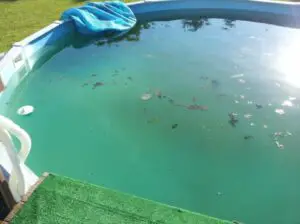
Don’t be afraid to shock your pool whenever necessary.
While this procedure is usually discussed for public pools, think about how your pool is after a pool party. Chances are it is murkier than it had been before the big bash. It’s contaminated with bacteria that you want to eliminate as soon as possible.
Shocking refers to raising the chlorine levels to get rid of bacteria. It’s carried out by diluting three to four times the average amount of chlorine or other sanitizers with water, slowly pouring it in the pool’s return line, allowing it to filter throughout the pool, then slowly refilling the water into the pool over time.
While shocking too frequently would risk damage to your pool siding, you should try to shock your pool a minimum of two times a season.
6. Keep an Eye on Water Level
The physical level of water is as essential as the chemical level.
Water level will usually fluctuate after a day of children doing cannonballs or a rainstorm.
You want to keep your water level at around halfway up your skimmer’s opening.
Just use a garden hose to bring the required level if the water is too low.
If the water level is high, rent a pump from a home improvement store to drain the surplus.
If your pool liner is a fiberglass or vinyl material that may be damaged by the weight of the pump, consider consulting with a professional.
When you have got a suitable water level, don’t forget to recheck the chemicals. Water level fluctuations may have thrown back.
7. Use a Ball to Absorb Oils
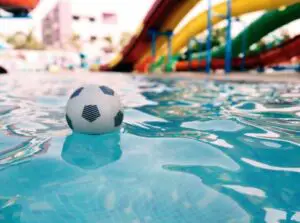
When people think of tennis balls in a swimming pool, most of the time they think of the neighbor’s kids throwing them too far.
But those sport balls can also do double duty.
Most swimmers leave lots of oils in the pool – including natural oils, suntan lotion, and hair products. While it’s unpleasant to consider, luckily there’s a simple solution.
Throw a tennis ball into your pool. The ball is made up of fibers that help to absorb these oils and support to leave a shiny appearance on the water.
8. Power Wash Your Pool Deck
The area that surrounds your pool is equally important as the physical structure of your pool. With regular power washing, you can help keep your pool deck shining and keep organisms and debris out of your pool.
Power washing and pressure washing will help eliminate weather or rust spots that occur over time.
Begin the procedure by sweeping the deck free of leaves or any dirt, so you don’t wind up spreading them all over while cleaning.
Then, place the pressure washer according to the directions. Put a low to medium power spray with the machine and get rid of the surface debris in layers, until the surface is clean, repeat the process till you get a clean surface.
Be sure to overlap the areas you have cleaned to help avoid streaks as you spray. You’ll wish for the nozzle of the power washer some feet off of the pool deck surface and keep this height to prevent gouging.
9. Schedule A Yearly Service Appointment — Whether You Think You Need It or Not

When it comes to the mechanical equipment of your pool – pumps, heating systems, and filters — you might not have the knowledge for care.
At least once annually, have a pool service professional come out to check your pool equipment.
Before your appointment, take a thorough look at your entire sysytem. Compile a list of leaks you see in the piping, holes you detect from linear/loud noises coming from the mechanism or smells coming from the water. Share this with your pool service tech before they leave, so they bring the proper tools and parts with them.
If there’s nothing amiss with your swimming pool, the service appointment might seem like a waste of money and may be tempting to cancel.
But remember: finding and repairing a small leak or breaking motor now can save you from having to resolve really expensive system replacement later on.
10. Learn How To Winterize Properly
Though pool maintenance is of course essential through the summer, it is even more important to make sure your pool is secured properly during the winter.
After all, nobody wants to remove a pool cover at the beginning of summer to learn that their water is filled with harmful bacteria or their swimming pool has a leak.
By taking the right steps to winterize your swimming pool, you can save plenty of money and time for time use.
Purchase a water testing kit to make sure your chemicals are balanced before closing shop in the autumn. Then, take any excess water out of your plumbing line and invest in a pool cover to keep debris out of your pool.
Maintaining a pool does entail work, but it does not have to be a burden.
You and your family will spend more time sunbathing if you incorporate these pool care tips – and the right cleaning machines – into a regular cleaning routine.


